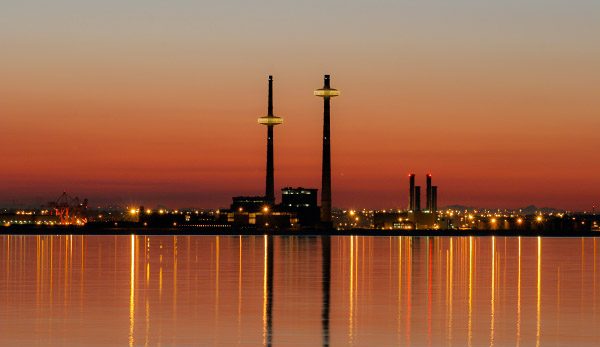
Pictured: Artist’s reconstructions of the poolbeg towers as a future development plan by the Urban Agency.
For most Dubliners the Poolbeg chimneys are a familiar and well-loved feature of the city’s landscape.
The chimneys have knitted their way into the historical and cultural fabric of urban Dublin and most would agree that any photograph or painting of the ever-changing Dublin skyline would be incomplete without the presence of these two iconic red and white striped chimney stacks .
Although the demolition of the two chimneys was once feared, the people of Dublin can now rest assured that the much loved skyline staples are here to stay. But while the chimneys may not be going anywhere anytime soon, the question of how or even if they will be repurposed still remains.
Urban Agency is an award-winning international architectural firm with offices based in Dublin’s Grand Canal area. The agency aims to create innovative architectural solutions to address the contemporary challenges of city living. The firm have created a proposal which sets out their plans for the Poolbeg chimneys. The plans include twin observation towers with a 180-metre-high observation deck and a 160-metre-high restaurant, a venue for fundraising, conferences and corporate events, a publically accessible energy museum, education centre, shop, café and toilet facilities.
The co-founder of Urban Agency, Maxime Laroussi, believes the re-design would regenerate not only the building itself but also the surrounding areas by influencing tourism and economic growth. “This is a perfect example of how you can regenerate an area which has been neglected, like the (Dublin) docks and make it into a public destination,” says Laroussi.
“It’s an important project for the people of this city as it has meaning to them,” says Laroussi. “It’s an important piece of infrastructure and the public should be benefiting from it. Things need to be sustainable financially and if something doesn’t stand up financially, we need to give it another meaning in order to be able to give it a longer life.”
As anyone who has seen the recent drone videos taken from the top of the chimneys will know, the view from the topof the chimneys is by far their biggest asset. “No other structure has its height, especially in a place like Dublin, where there are mostly low-rise buildings,” says Laroussi. “It already has the height asset so most of the work has already been done by accident in a sense.”
“The idea is to propose two viewing towers – one at 180 metres from the ground and the other at 160 metres. The lower one would have the panoramic restaurant a bit like the rotating restaurant they have in Toronto, and the highest tower could be more like a viewing platform where people can pay to go up and see the view.
“In the bottom there would be a cultural centre and museum about energy and power as it used to be an ESB chimney. These kind of features are great for educating and creating awareness,” says Laroussi.
The company estimates that the cost of the project would be between 8-10 million euro. According to Laroussi, potential funding for the project could come from a number of different places including the government, Dublin Port or private investors.
When considering a potential demolition of the chimneys, the structural integrity of the buildings was one of the main concerns voiced by the ESB. It’s unknown whether building upon these aging structures would even be possible, however this is not a concern that Urban Agency shares.
“We haven’t looked into that detail yet,” says Laroussi, “but structurally, nothing is impossible, engineers can do amazing things.”
Urban Agency have listed Dublin City Councillor and historian, Dermot Lacey, as an imagined potential client for their proposal, due to his involvement in the campaign which fought to prevent the chimneys demolition. However, Cllr Lacey is by no means jumping to support the Urban Agency proposal.
“There are lots of imaginative proposals. My own view is that there should be some form of architectural competition,” says Lacey, whose primary aim is to see the chimneys restored as a piece of urban heritage. “You couldn’t jump to support one proposal without inviting many others to submit. However doing something positive with them would be welcome. I don’t think the chimneys are hugely strong structures though, so I think they would need a lot of reinforcement.”
He added: “I see the chimneys becoming a focal point for that part of Dublin. Together with a restoration of the old Red Brick Power Station and the proper use of the Pigeon House Hotel we could create a great new destination area linking the sea, the arts and industrial heritage.”
by Paula Boden



